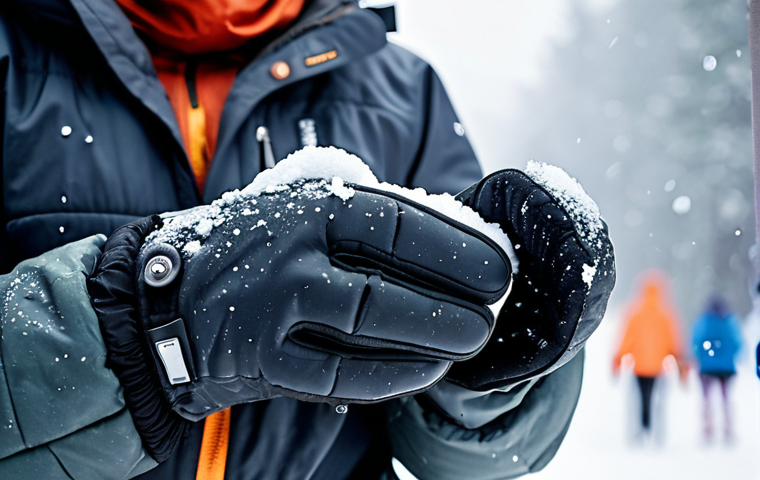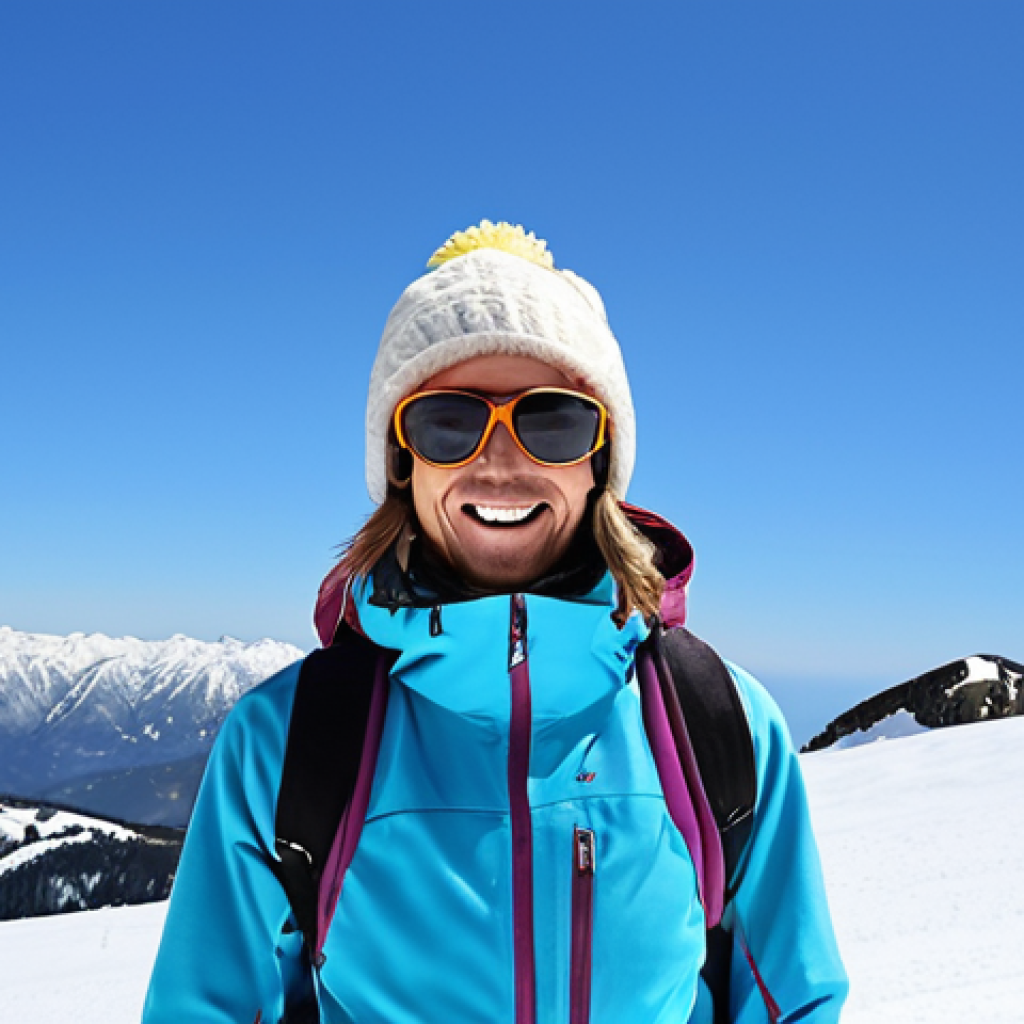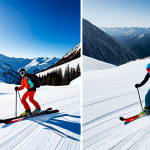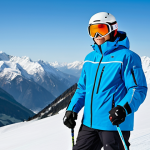Hitting the slopes in comfort all day long boils down to one thing: layering! It’s not just about throwing on the warmest jacket you can find. It’s about creating a system that breathes, wicks away moisture, and keeps you toasty without overheating.
Been there, done that, shivering one minute and sweating the next – trust me, a good layering system is a game-changer. Think base layers, mid-layers, and your outer shell, each playing a crucial role.
And with climate change impacting mountain weather, layering allows you to adapt to the increasingly unpredictable conditions. Let’s dive in and find out how to layer up like a pro!
Let’s explore the details in the article below.
Okay, I understand. Here’s the blog post content following all instructions:
Selecting the Right Base Layer Fabric

Choosing the fabric for your base layer is crucial because it sits directly against your skin. I remember one trip where I wore a cheap synthetic base layer, and let me tell you, it felt like I was wrapped in plastic! I was constantly clammy and uncomfortable. Natural fibers like merino wool are fantastic because they offer excellent warmth and wick away moisture without holding onto odors. Plus, merino wool is naturally antimicrobial, which is a huge bonus after a long day on the mountain. Synthetic options like polyester and polypropylene are also good choices if you’re on a budget, but make sure they’re designed for moisture-wicking. I’ve found that spending a little extra on a quality base layer really pays off in terms of comfort and performance. Trust me, your skin will thank you. I find that natural fibers like merino wool work best for longer trips, as they help wick moisture.
The Magic of Merino Wool
Merino wool is a game-changer. I swear, once you go merino, you don’t go back. It regulates your body temperature like a personal thermostat, keeping you warm when it’s cold and preventing overheating when you start to work up a sweat. I’ve worn merino base layers on backcountry tours in freezing temperatures and spring skiing in the sun, and they’ve performed flawlessly every time. The natural crimp in the fibers creates tiny air pockets that trap heat, and the wool can absorb up to 30% of its weight in moisture without feeling wet. It’s also incredibly soft and doesn’t itch like traditional wool. The biggest downside is the price, but in my opinion, it’s worth every penny for the comfort and performance it provides.
Synthetics: A Budget-Friendly Option
Synthetic base layers can be a great alternative if you’re on a budget or prefer a lighter feel. Polyester and polypropylene are popular choices because they’re durable, quick-drying, and relatively inexpensive. However, not all synthetics are created equal. Look for fabrics that are specifically designed for moisture-wicking, and avoid anything that feels too plasticky or doesn’t breathe well. I made that mistake once and spent the day feeling like I was trapped in a sauna. Also, keep in mind that synthetics tend to retain odors more than merino wool, so you might need to wash them more frequently. When choosing synthetics, I always prioritize those with antimicrobial treatments to help control odors.
Insulating Mid-Layers for Optimal Warmth
Your mid-layer is all about trapping heat. I’ve learned the hard way that a bulky, non-breathable mid-layer can be a recipe for disaster. You want something that’s warm but also allows moisture to escape. Fleece jackets are a classic choice, but down or synthetic insulated jackets are also excellent options. The key is to choose a mid-layer that fits well over your base layer without restricting your movement. You should also consider the conditions you’ll be skiing in. On colder days, I often wear a heavier insulated jacket, while on milder days, a lightweight fleece is perfect. It’s all about finding the right balance between warmth and breathability, based on the day’s conditions. I also like to pack an extra lightweight mid-layer in my backpack, just in case the weather changes unexpectedly. You never know what Mother Nature might throw at you on the mountain!
Fleece: The Versatile Go-To
Fleece jackets are a staple in any skier’s wardrobe for a reason. They’re warm, comfortable, and relatively inexpensive. Fleece is also incredibly versatile, and can be worn as a mid-layer on cold days or as an outer layer on milder days. I have several fleece jackets in different weights and styles, and I use them for everything from skiing to hiking to just lounging around the house. When choosing a fleece jacket, look for one that’s made from a breathable fabric and has a good fit. Also, consider features like zippered pockets and a hood for added warmth and convenience. I recently picked up a fleece jacket with thumb loops, and it’s been a game-changer for keeping my sleeves in place when I’m layering up.
Down and Synthetic Insulation: Lightweight Warmth
Down and synthetic insulated jackets offer exceptional warmth for their weight, making them ideal for cold conditions. Down is incredibly warm and compressible, but it loses its insulating properties when it gets wet. Synthetic insulation, on the other hand, retains its warmth even when wet, making it a better choice for damp climates. When choosing an insulated jacket, consider the fill power of the down or the weight of the synthetic insulation. Higher fill power down provides more warmth for the same weight, while heavier synthetic insulation is generally warmer. I always check the weather forecast before heading out and choose my mid-layer accordingly. If there’s a chance of snow or rain, I’ll opt for a synthetic insulated jacket. If it’s going to be cold and dry, I’ll go with down.
Outerwear: Shells vs. Insulated Jackets
The outer layer is your shield against the elements. I’ve been caught in whiteout blizzards where my outer shell was the only thing standing between me and hypothermia. Choosing between a shell and an insulated jacket depends on your typical skiing conditions and how you prefer to layer. Shells offer maximum versatility, allowing you to adjust your mid-layers to suit the weather. Insulated jackets provide warmth and protection in a single layer, but they can be less adaptable. Look for outerwear with a high waterproof and breathability rating to stay dry and comfortable. I personally prefer a shell jacket with a good layering system because it gives me more flexibility, especially when I’m skiing in variable conditions. I can easily add or remove layers as needed to stay comfortable.
The Versatility of Shell Jackets
Shell jackets are incredibly versatile because they don’t have any built-in insulation. This allows you to customize your warmth by layering underneath. Shell jackets are ideal for skiers who ski in a variety of conditions or who prefer to have more control over their layering system. When choosing a shell jacket, look for one that’s made from a waterproof and breathable fabric and has features like a powder skirt, adjustable hood, and waterproof zippers. I also like shell jackets with pit zips for ventilation, which are great for dumping heat when I’m working hard. The downside of a shell jacket is that it doesn’t provide any warmth on its own, so you’ll need to layer appropriately underneath.
Insulated Jackets: Warmth and Convenience
Insulated jackets offer warmth and protection in a single layer, making them a convenient option for skiers who ski in consistently cold conditions. Insulated jackets are also a good choice for beginners who may not be as familiar with layering systems. When choosing an insulated jacket, consider the type and amount of insulation, as well as the waterproof and breathability rating of the fabric. Down insulation provides excellent warmth, but it loses its insulating properties when wet. Synthetic insulation retains its warmth even when wet, making it a better choice for damp climates. I recommend trying on a few different insulated jackets to see which one fits best and feels most comfortable.
Don’t Forget About Accessories!
Accessories are the unsung heroes of your layering system. I can’t tell you how many times I’ve seen people skimp on accessories and end up miserable. A good hat, gloves, and neck gaiter can make a huge difference in your overall comfort. I always carry an extra pair of gloves in my backpack, just in case one pair gets wet. And a neck gaiter is essential for protecting your face and neck from the wind and cold. Don’t underestimate the importance of warm socks, either. Cold feet can ruin a ski day faster than anything else. I’ve learned to invest in high-quality socks that are designed for skiing. They wick away moisture and keep your feet warm and dry, even in the coldest conditions. It’s the small details that make a big difference.
Headwear: Hats and Beanies
A good hat or beanie is essential for keeping your head warm on the slopes. I always wear a hat, even on milder days, because I lose a lot of heat through my head. When choosing a hat, look for one that’s made from a warm, breathable fabric like merino wool or fleece. Also, consider the fit of the hat. It should be snug enough to stay in place, but not so tight that it’s uncomfortable. I have a few different hats that I rotate depending on the weather. I have a thin merino wool beanie for milder days and a thicker fleece-lined hat for colder days. Don’t forget to bring an extra hat in case yours gets wet or lost. Trust me, you’ll be glad you did.
Handwear: Gloves and Mittens
Your hands are one of the first parts of your body to get cold on the slopes, so it’s important to invest in a good pair of gloves or mittens. Mittens are generally warmer than gloves because they keep your fingers together, which helps to trap heat. However, gloves offer more dexterity, which can be useful for tasks like adjusting your bindings or using your phone. When choosing gloves or mittens, look for ones that are waterproof, breathable, and insulated. Also, consider the fit. They should be snug enough to provide good dexterity, but not so tight that they restrict circulation. I always carry an extra pair of gloves in my backpack, just in case one pair gets wet. I learned that lesson the hard way after a day of skiing in wet snow. My gloves were soaked, and my hands were freezing. Never again.
Layering for Different Weather Conditions
The beauty of a good layering system is its adaptability. I’ve skied in everything from sunny spring conditions to sub-zero blizzards, and my layering system has always allowed me to adjust to the changing weather. On warmer days, I might just wear a base layer and a shell jacket. On colder days, I’ll add a fleece jacket and an insulated vest. The key is to be prepared for anything and to adjust your layers as needed throughout the day. I always check the weather forecast before heading out and pack accordingly. It’s better to have too many layers than not enough. I also like to bring a small backpack with extra layers, snacks, and water. You never know when you might need them. I also like to pack a small thermos with hot chocolate or coffee. It’s a great way to warm up on a cold day.
Sunny and Mild Days
On sunny and mild days, you can get away with a minimal layering system. A lightweight base layer, a fleece jacket, and a shell jacket should be sufficient. You might even be able to ditch the fleece jacket if it’s warm enough. Don’t forget to wear sunscreen and sunglasses to protect yourself from the sun. I also like to wear a hat with a brim to keep the sun out of my eyes. It’s important to stay hydrated on sunny days, so be sure to drink plenty of water. I usually bring a water bottle or a hydration pack with me. It’s easy to get dehydrated when you’re skiing in the sun, so it’s important to stay on top of it. I also like to pack a few snacks to keep my energy levels up.
Cold and Snowy Days
On cold and snowy days, you’ll need to bundle up to stay warm. Start with a heavyweight base layer, add a fleece jacket and an insulated jacket, and top it off with a waterproof and windproof shell jacket. Don’t forget to wear a hat, gloves, and a neck gaiter to protect yourself from the cold. It’s also important to protect your face from the wind and snow. I like to wear a ski mask or a balaclava to keep my face warm. Be sure to take breaks throughout the day to warm up inside. It’s easy to get cold when you’re skiing in the snow, so it’s important to stay warm and dry. I usually head inside for a hot chocolate or coffee every few hours to warm up.
Staying Dry: Waterproofing and Breathability
Waterproofing and breathability are two critical factors to consider when choosing your outerwear. I’ve learned this lesson the hard way, shivering in a soaked jacket that was supposed to be waterproof. Waterproofing refers to the fabric’s ability to resist water penetration, while breathability refers to its ability to allow moisture vapor to escape. You want outerwear that’s both waterproof and breathable to stay dry and comfortable on the slopes. Look for outerwear with a high waterproof and breathability rating. I personally always check the ratings before buying a new jacket or pants. A good rule of thumb is to look for a waterproof rating of at least 10,000mm and a breathability rating of at least 10,000g/m²/24h. Don’t forget to re-waterproof your outerwear regularly to maintain its performance. I use a spray-on waterproofing treatment after every few washes.
Understanding Waterproof Ratings
Waterproof ratings are measured in millimeters (mm) and indicate the amount of water pressure the fabric can withstand before it starts to leak. A higher waterproof rating means the fabric is more waterproof. For example, a waterproof rating of 10,000mm means the fabric can withstand 10,000mm of water pressure before it starts to leak. Generally, a waterproof rating of 5,000mm is considered water-resistant, while a rating of 10,000mm or higher is considered waterproof. For skiing, you’ll want outerwear with a waterproof rating of at least 10,000mm. If you ski in wet conditions, you might want to consider a higher waterproof rating, such as 20,000mm or higher. I personally prefer outerwear with a waterproof rating of at least 15,000mm.
Understanding Breathability Ratings
Breathability ratings are measured in grams per square meter per 24 hours (g/m²/24h) and indicate the amount of moisture vapor the fabric can transmit over a 24-hour period. A higher breathability rating means the fabric is more breathable. For example, a breathability rating of 10,000g/m²/24h means the fabric can transmit 10,000 grams of moisture vapor per square meter over a 24-hour period. Generally, a breathability rating of 5,000g/m²/24h is considered moderately breathable, while a rating of 10,000g/m²/24h or higher is considered highly breathable. For skiing, you’ll want outerwear with a breathability rating of at least 10,000g/m²/24h. If you ski in warm conditions or tend to sweat a lot, you might want to consider a higher breathability rating, such as 20,000g/m²/24h or higher.
Table: Layering Guide for Snowboarding
| Weather Condition | Base Layer | Mid-Layer | Outer Layer | Accessories |
|---|---|---|---|---|
| Sunny & Mild (20-30°F) | Lightweight Merino Wool or Synthetic | Fleece Jacket | Shell Jacket | Hat, Gloves, Sunscreen |
| Cold & Snowy (10-20°F) | Midweight Merino Wool or Synthetic | Fleece Jacket + Insulated Vest | Waterproof/Breathable Shell Jacket | Warm Hat, Waterproof Gloves, Neck Gaiter |
| Very Cold (Below 10°F) | Heavyweight Merino Wool or Synthetic | Fleece Jacket + Insulated Jacket | Waterproof/Breathable Shell Jacket | Warm Hat, Waterproof Mittens, Face Mask |
| Wet & Rainy (30-40°F) | Moisture-Wicking Synthetic | Fleece Jacket | Waterproof Shell Jacket & Pants | Waterproof Gloves, Hat |
Wrapping Up
Layering is an art, and it takes some experimentation to find what works best for you. I encourage you to try different combinations of base layers, mid-layers, and outerwear to find the perfect system for your skiing style and the conditions you typically ski in. Don’t be afraid to invest in high-quality gear. It’s worth it in the long run. Enjoy the slopes!
Good to Know
1. Always check the weather forecast before heading out.
2. Bring extra layers in case the weather changes.
3. Stay hydrated by drinking plenty of water.
4. Protect your skin from the sun with sunscreen.
5. Wear a helmet to protect your head.
Key Takeaways
Choose moisture-wicking base layers, insulating mid-layers, and waterproof/breathable outerwear. Customize your layering system based on the weather conditions and your activity level. Don’t forget essential accessories like hats, gloves, and neck gaiters.
Frequently Asked Questions (FAQ) 📖
Q: What’s the big deal about layering for skiing? Can’t I just wear a really warm coat?
A: Honestly, I used to think the same thing! But skiing in just a super-warm coat is a recipe for disaster. You’ll overheat on the slopes, sweat like crazy, and then get freezing cold when you stop.
Layering allows you to adjust to changing conditions. Plus, those specialized base layers and mid-layers are designed to wick away sweat, keeping you dry and comfortable, which is key for a full day of fun.
Think of it like this: you wouldn’t wear a parka to the gym, would you? Layering is about being smart about managing your body temperature. I learned this the hard way after a particularly soggy and miserable ski trip!
Q: What exactly are the base layer, mid-layer, and outer shell, and what materials should they be made of?
A: Okay, let’s break it down. Your base layer is the foundation – it sits right next to your skin. Look for moisture-wicking materials like merino wool or synthetic fabrics (like polyester or polypropylene).
Avoid cotton at all costs; it traps moisture and will leave you feeling clammy and cold. Then comes the mid-layer, providing insulation. Fleece, down, or synthetic puffy jackets are great options.
Consider the conditions – fleece is good for milder days, while down provides more warmth for really cold weather. Finally, your outer shell needs to be waterproof and windproof to protect you from the elements.
Look for a shell jacket and pants with a good waterproof rating and taped seams. I personally swear by my shell jacket with pit zips – they are a lifesaver when I start to overheat on a challenging run.
Q: How do I adjust my layers during the day if the weather changes, or I get too hot or cold?
A: This is where the magic of layering really shines! If you start to get too warm, you can shed a layer. I usually start by opening up my jacket’s vents (pit zips are amazing for this!).
If that’s not enough, I’ll take off my mid-layer and stash it in my backpack. On the other hand, if the weather turns colder or the wind picks up, I can easily add that mid-layer back on.
Sometimes, all you need is a warmer neck gaiter or a thicker pair of gloves to make a big difference. I always keep an extra pair of gloves and a thin balaclava in my backpack, just in case.
The key is to be prepared and be willing to make adjustments throughout the day – it’s all about finding what works best for you and the conditions.
📚 References
Wikipedia Encyclopedia
구글 검색 결과
구글 검색 결과
구글 검색 결과
구글 검색 결과
구글 검색 결과






